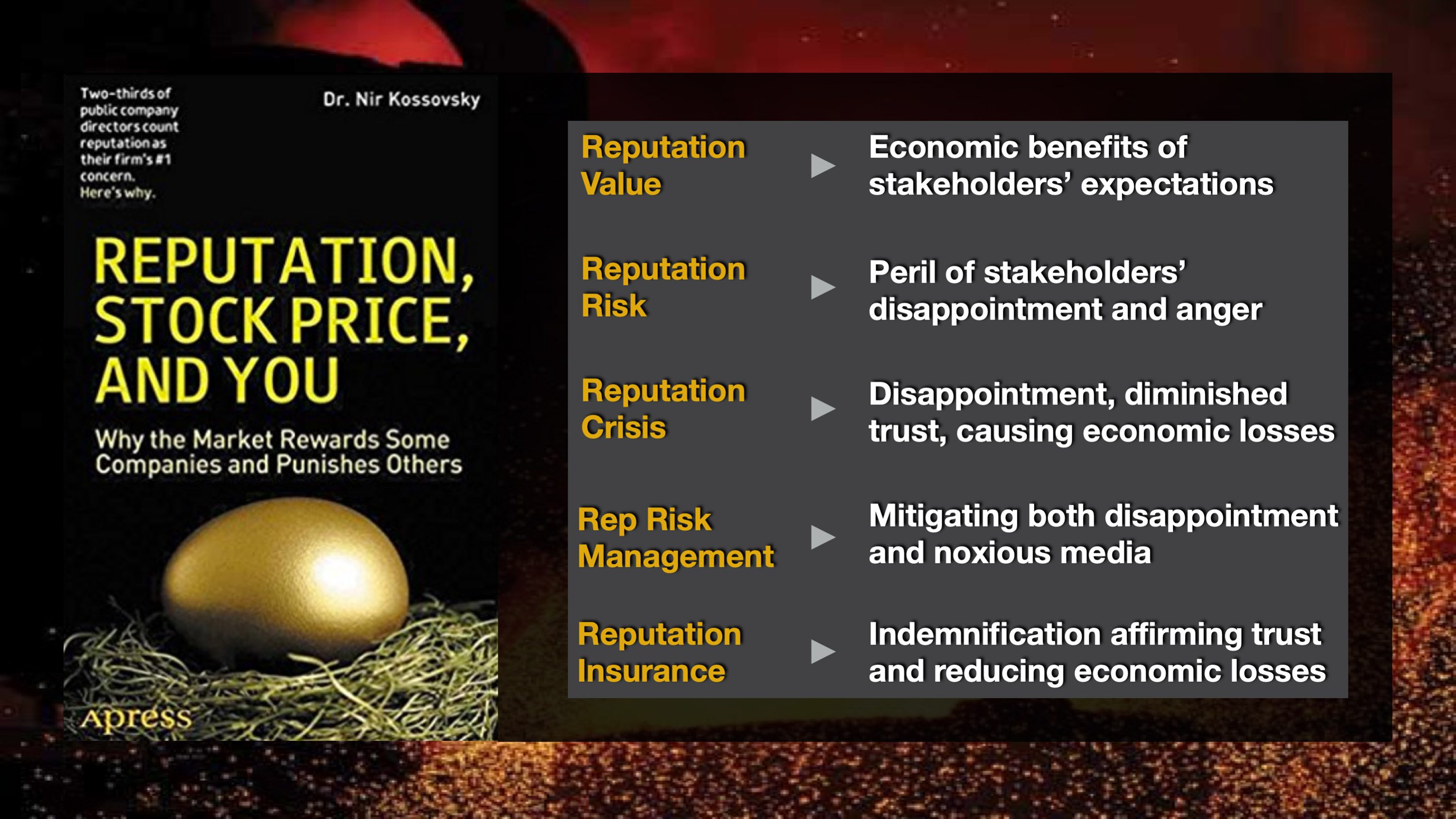Reputation Stock Price and You
Product details (Amazon)
Paperback: 308 pages
Publisher: Apress; 1st ed. edition (November 19, 2012)
Language: English
ISBN-10: 1430248904
ISBN-13: 978-1430248903
Product Dimensions: 6 x 0.7 x 9 inches
Shipping Weight: 1.1 pounds (View shipping rates and policies)
Average Customer Review: 5.0 out of 5 stars 6 customer reviewsComments and reviews from Amazon.
I am pleased I got his book. Nice work Nir!
This is just one example of the thorough and credible positioning of the value of corporate reputation and why organizations that are socially and environmentally credible essentially fashion a “reservoir of goodwill” that enables them to become more resilient not only to climate change risks, but to any unfavorable market perception.
The Deepwater explosion was a pivotal failure in management where cost containment and disregard for safety ran rampant. BP will pay the price for a long time to come before it can restore its reputation for crisis prevention and management. Tangible impacts included the firing of the CEO, decline in employee morale and satisfaction benchmarks, a 16% increase in the net cost of credit over 2009, a credit downgrade from AA to A, and an estimated net $54 billion in lost market capitalization.
Dr. Kossovsky’s expose of the dramatic decline of reputation and the associated stock market ramifications for BP following the Deepwater Horizon disaster in 2010 is illuminating. A concerted effort began in the 1990s to reposition oil behemoth BP as sustainable, green, and concerned corporation. BP acknowledged the problems posed by climate change, formulated internal carbon reduction targets and programs, and invested over $8 billion over the course of a decade in renewable fuel alternatives. The market responded favorably and despite the explosion at BP’s Texas refinery in 2005 and the oil spill in Alaska in 2006, the media continued to portray BP as a concerned global citizen committed to a carbon constrained world and to alternative fuel development.
Dr. Kossovsky’s book offered a clarity for me in linking long-term shareholder value to corporate resilience, and on to reputational management. His contention is that there are six distinct drivers that support or undermine corporate reputation. They are, ethics, innovation, quality, safety, sustainability, and enterprise security. Adequate management of reputation by senior executives and reputation oversight by the board of directors is essential to safeguard fiscal health. This is very relevant given that corporate heads that grasp the relationship between reputation and intangible asset value, and enhancing the firm’s reputation can lead to an increase of 6% to its traded value. In contrast, any major catastrophe suffered by the firm can cut 7% of its value . Disclosure of reputational risk by S&P 500 organizations has dramatically increased from just 40 firms in 2009 to 355 in 2012
April 17, 2013
This is a thoroughly researched and thoughtful work. Reputational issues effectively are addressed intuitively, from the perspective of diverse stakeholders and through surprisingly illuminating metrics.
March 14, 2013
Reputation, the Most Important Metric?
Over the last few weeks, I have enjoyed reading Mission Intangible alongside Nir Kossovsky’s latest book, Reputation, Stock Price and You. The whole body of work is thought provoking as the components of reputational value are detailed. From an enterprise risk management (ERM) and insurance perspective, my sense is that large enterprise risk gaps will be exposed by reputational analysis. If COSO created ERM 1.0 and the SEC’s Board Risk Oversight Proxy Disclosure Enhancements promoted ERM 2.0, Kossovsky’s excellent work should evolve ERM into version 3.0, i.e., there is now a whole new framework for risk management that should be considered for creating enterprise value.
January 2, 2013
I apprecaite the author approach to a topic which few have dared to quantify. I still think the industry has a ways to go but Kossovsky has made a meaningful contribution to that progress.
May 31, 2015
I apprecaite the author approach to a topic which few …
A tour de force on connecting the supposedly “intangible” to the tangible – Dr. Kossovsky, through meticulous research, and compelling data, shows that a reputational hit can shave material value off of a company’s stock value and, even more importantly, how reputational repair and the creation of internal organizational resilience can add back up to a net 13.5% in stock value. If one extrapolates this lesson from publicly traded companies to other types of organization, it makes for a compelling case for building resilient, well-risk managed and strategically aligned enterprises.
October 24, 2014
A tour de force on connecting the supposedly “intangible” to …
“Reputation, Stock Price and You” by Dr. Nir Kossovsky is a very important addition to the (too slowly, IMHO) growing body of serious analysis about the role reputation plays in creating – and protecting – corporate value. Kossovsky takes the core principle of corporate reputation – that it’s about stakeholders and their judgments about companies – and examines current examples of reputation strengths and missteps from the perception of each primary stakeholder group. He provides clear examples drawn from today’s headlines so the information is relevant to managers. He makes a convincing case that reputation is not simply a PR or marketing exercise (although communications are important) but should be managed at the same level as key risk decisions. When I began my career in reputation management there were few pieces of research that helped me build the case for a new discipline in the global financial services company where I worked at the time. I had to cobble together a collection of academic journal articles, some data from a very small number of players, and a few essays. Managers today have this book to help them make the case, along with a roadmap to build a plan. Of course, they can always hire a consultant like me to help – but the astute manager will read this book to understand the magnitude of effort – and importance – of a robust reputation management platform. Ultimately, reputation is built and destroyed in the business decisions made each day by managers at all levels. This book details the kinds of decisions that decimated the value of great brands because they no longer met the expectations of their stakeholders, and the need for enterprise-wide competence at making reputation-centric decisions. In addition to being packed with current data the book is eminently readable. The writing is imbued with a sense of energy that engages the reader. It is organized with stories pulled from the news and summary points to highlight the key takeaways. I found gold in the footnotes with extensive references that together provide the essential guide to reputation management for managers and executives. This book should be required reading for MBAs and managers of business large and small. Dr. Kossovsky has made yet another important contribution to the discipline.
January 16, 2013
The new source book on corporate reputation
November 1, 2012
Reputation Stock Price & You
Reputation, Stock Price and You: Why the markets reward some companies and punish others (Apress 2012).
- Reputation value: economic benefits of stakeholders’ expectations.
- Reputation risk: peril of stakeholders’ disappointment and anger.
- Reputation crisis: disappointment, diminished trust, causing economic losses.
- Reputation risk management: mitigating both disappointment and noxious media.
- Reputation insurance: indemnification affirming trust and reducing economic losses.
Reputations are valuable strategic intangible assets. Threats to these assets⏤ enterprise reputation risks, often mislabeled “brand risks” ⏤ need to be managed, and management needs to be overseen through reputation risk governance lest reputational damage or reputational harm result in long-tailed go-forward losses in economic value and/or political power. Because these intangible risks arise from the interplay of stakeholder expectation, experiences, and media amplification, parametric insurances for intangible asset risks, for reputational value, for reputational harm, and for reputation assurance help mitigate risk by telling a simple, convincing and completely credible story of quality reputation governance to stakeholders. This story telling effect is the expressive power of insurance complementing insurance’s better known instrumental power of indemnification.
Risk management, risk financing in insurance captives, and risk transfer through reputation insurances comprise the constituent elements of a comprehensive solution. Are ESG insurance or reputation insurance part of your strategy?

